#Kurrent
Explore tagged Tumblr posts
Text

I have, after a very long time, started to practice Kurrent again. Here's a letter from Liselotte von der Pfalz. Why the grapes? Well, the answer is in the letter! 😉
20 notes
·
View notes
Text
do americans bitching about cursive being illegible know about kurrent
#you want something illegible try writing a word with a lot of ms ns and is in kurrent#now THATS illegible
92 notes
·
View notes
Text
The ghosts and German handwriting
Completely niche, self-indulgent topic no one cares about except me but I would really love an episode in S2 where Emma finds an old hand-written document that she wants to decipher, and she goes to the ghosts for help, only to find that none of the ghosts can read it either because 1) it's just plain bad handwriting and 2) it's written in this specific handwriting that was only taught in schools from the 1910s to the 1940s and they don't have a ghost from that period on hand. Context: Around the beginning of the Modern era, in Germany (and some other countries too but this is about Germany) people started using two parallel handwriting systems. One, the so-called Latin cursive, was very close to the cursives used in other countries at the time and can still be read somewhat easily today. The other, the more commonly used one, was called Kurrent. Which one you used depended on context. Loan words, place names and quotes for example would often be written in Latin cursive, even if the rest of the text was in Kurrent. Here an example of the word Generalienmäßig (in the manner of generals) which has the first half written in Latin cursive and the second part in Kurrent to show the difference.

People nowadays still learn cursive in school (at least they did when I was in school) but since the 40s they'd only learn a cursive close to the Latin one. Kurrent has completely disappeared from schools and now you'll mostly only encounter it at the university level when you're studying history or archival science or something similar. Svenni and Joachim probably didn't learn how to read/write it. But, if Kurrent has been around for so long, wouldn't Friedrich or Adelheid be able to read it? Generally, yes. But of course writing styles have evolved over the 200+/100+ years since they've been dead as well. Here's what Friedrich's handwriting could have looked like:
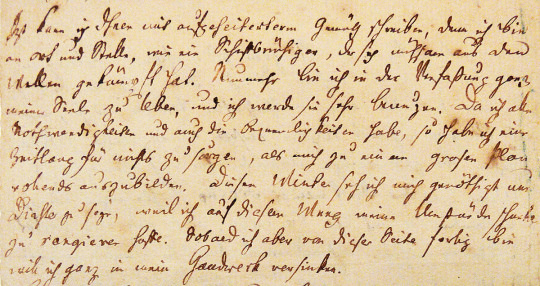
(This one's a bit of a mix of Kurrent and Latin cursive but wikimedia didn't have any other good examples for Friedrich's time so it is what it is lol Here are Friedrich's and Ludwig's actual handwritings from the show, even if they're not very legible. Kudos to the set dressers and the actors for actually using Kurrent!)
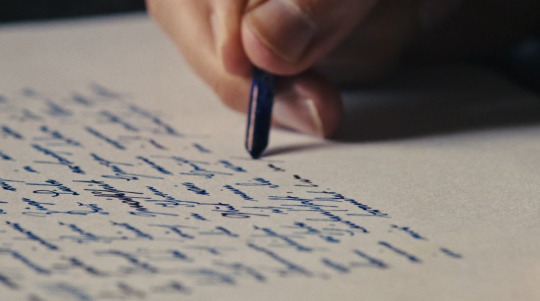
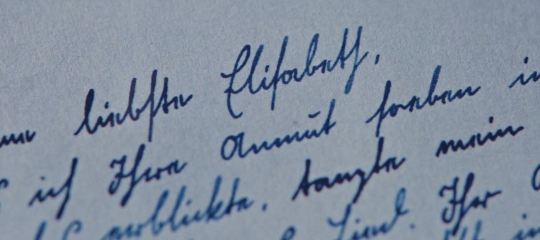
And this is what Adelheid's Kurrent could have looked like:
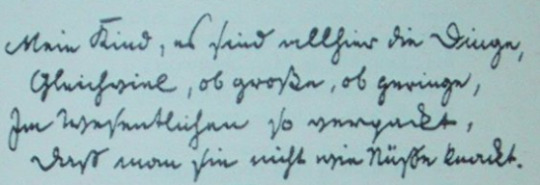
Okay but now to the super specific 1910s to 1940 kinda Kurrent! It's called Sütterlin after the guy who invented it, it was in part inspired by the Jugendstil/Art Nouveau art movement and its main goal was to simplify the cursive for school kids to learn it easier. It looks a little something like this:

This one's a pretty neat and legible example but if the handwriting was really bad, on top of it being a new variant of Kurrent, even Friedrich and Adelheid could struggle a bit to read it. In the end of the episode maybe they find a new ghost that can read it, maybe it gives Urs a moment to shine or maybe it was Lotti's diary all along, any of these outcomes would be a lot of fun~ (And just for completion's sake, I don't know if Urs and Griet can write and/or read, but I'm sure Claudius can and his handwriting would probably look like this (which also wouldn't be very useful to Emma's deciphering quest lol):

#ard ghosts#die geister#I'm gonna close like 20 tabs now lol#Some of the examples have transcriptions in the source link if you're curious#Kurrent my beloved/beloathed#Why I have a very normal relationship to historical handwriting thank you for asking#thing I made
44 notes
·
View notes
Text

Hellsing 2002 calendar illustration.
Ein wunderliche und erschröckliche Hystori von einem großen Wüttrich genant Dracole wayda Der do so ganz unkristenliche marrter hat angelegt die mensche, als mit spissen als auch die leut zu Tod geslyffen
A wondrous and frightening story about a great berserk called Dracula the voivode who inflicted such unchristian tortures such as with stakes and also dragged people to death
#hellsing#alucard#kouta hirano#translation was found in a comment by u/lazyfoxheart on r/Kurrent#fun fact this is the highest quality version of this image that exists online#i know because i've been looking forever for a version that's clear enough to actually read what hirano wrote under '1443'#but there weren't any so i had to take matters into my own hands#the real image on the back of the guidebook is only 2 inches tall so i had to take this with my smartphone and will my hands not to shake#anyway i'm pretty sure it's supposed to say Eğrigöz (the location vlad was imprisoned) so yeah. thank you hirano very cool#if i might rant for a sec it took me an embarrassingly long time to figure that out because i didn't have the guidebook at first#and in the images i could find online that part was just a blur that looked suspiciously like a person's signature and i was like. who tf#i was thinking matthias corvinus since he issued some political propaganda against vlad iirc but it didn't match his signature on wikipedia#then i thought it might be vlad II dracul's since he probably had to sign an agreement to send his sons over as hostages at some point#but that didnt seem right either so i kept skimming vlad's wiki page#and then i was like goddammit...hirano.....you just misspelled Eğrigöz didn't you.. ....#i maybe should've made a separate post dedicated to this instead of writing a novel in the tags but eh#the hellsing brainrot runs deep#also- i put it in the source link at the bottom of the post but the german inscription is copied off a real woodcut of vlad from 1491#except instead of depicting him as an adult hirano drew him as a child which gives the inscription a very different feel imo#the one final thing that interests me about this is the fact that hirano published this calendar in 2002#which is REALLY early in the series. like this was before volume 5 came out??#i have no idea why he decided to do a massive spoiler drop in a random piece of japan-only merch#sandwiched between a drawing of alucard as john travolta from saturday night fever and integra as a fish no less#it makes me really curious to know what the fan response to this was back then. like did people even know who this was#maybe im just an idiot and everyone back then was like 'ah yes its alucard as a 12 year old. how very informative'
116 notes
·
View notes
Text
"Liebe Mama! Nach einem herrlichen Rheinbad mit starker Strömung sitze im Börsenrestaurant. Ab 2.31 nach Baden-Baden und abends nach Freiburg. Wetter heiß & ohne Regen. Auf mehr Nachricht hofft [Unterschrift]" Dear Mom! After a wonderful bath in the rhine with a strong current, I'm sitting in the stock exchange restaurant. Starting 2:30 to Baden-Baden and then in the evening to Freiburg. Weather hot & no rain. Hoping for further messages [signature]

Street scene in Mannheim, Baden-Württemberg, Germany
German vintage postcard, mailed in 1904
32 notes
·
View notes
Text
"Your guy's handwriting doesn't seem that bad."
Oh really?


#it's fine when he's using his good handwriting#the pencil corrections however....#this man writes kurrent with like no curves in it#actually that one isn't his worst#I gave my brain a second to adjust to it#also caught replacing Ich with Wir again
17 notes
·
View notes
Text
Katana is an easily entertained cat. She loves to watch leaves blow across the backyard. Unfortunately, she loves it like a middle aged man loves watching sports, and it scares the shit out of me when she bangs her paws against the kitchen window
#thought someone was trying to break in#no. just my cat getting really excited about leaves#kurrently katana
5 notes
·
View notes
Text
Meme redraw to practise drawing faces because I have trouble with that. Also, procrastination. Mostly procrastination.
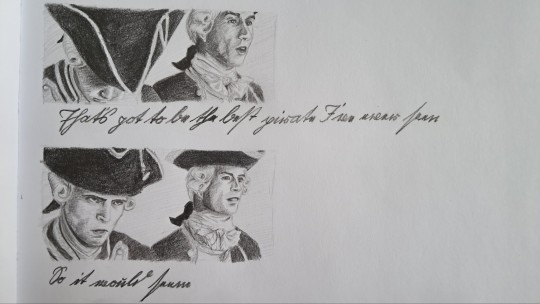
#ignore the Kurrent it's just the captions because I felt like it#potc meme#Theodore Groves#James Norrington#my posts#my art#One day I'll learn to use more than 5% of the paper but it is not this day
10 notes
·
View notes
Text
Save me Reddit
#they have helped me make progress#thank you to the guy who told me it wasn’t cursive and was likely kurrentschrift#just hoping someone will now be able to tell me what it says in the kurrent subreddit
3 notes
·
View notes
Text
happy kurentovanje !!!! 💐 🎨 🇸🇮
0 notes
Text
Goldberg, February 8th 1892 My faithful love! I arrived here 1 o'clock this afternoon from Liegnitz [modern day Legnica]. The connection is a bad one, so I'll be returning past 11 o'clock. Since this morning -since yesterday afternoon, really- it has been snowing nonstop and the white stuff is piling up high again already. If that doesn't get better, I won't be able to bring some good weather with me of course, but maybe we could go on a nice sleighride. As far as I can tell I'll be there on thursday afternoon, arriving from Dresden at 2:43. If something's holding me up, I'll write you again before if there's time. Now goodnight, Herzchen [little heart, a petname], and be deeply hearted [cuddled] and kissed by your - you heartily loving- Richard
German transcript:
Goldberg, 8/2 1892 Mein treues Lieb! Nach 1 Uhr Nachmittag bin ich von Liegnitz (Legnica) nach hier gefahren, die Verbindung ist eine schlechte, ich komme deshalb erst etwas nach 11 Uhr zurück. Seit heute früh, eigentlich gestern Nachmittag schneit es fast ununterbrochen und liegt das weiße Zeug schon wieder (?)lich hoch, wenn sich das nicht bessert, dann kann ich freilich kein gutes Wetter mitbringen, aber vielleicht könnten wir einmal eine hübsche Schlittenfahrt machen. So weit ich bis jetzt übersehen kann, bin ich Donnerstag Mittag von Dresden kommend 2:43 Uhr dort. Kommt aber noch etwas dazwischen, so schreibe ich Dir es, wenn noch Zeit bleibt, vorher noch. Nun gute Nacht, Herzchen, sei noch innig geherzt und geküsst von Deinem Dich herzlich liebenden Richard

Greetings from Breslau, present-day Wrocław, Poland
German vintage postcard, mailed in 1892
17 notes
·
View notes
Text
Me: huh, I really like this thing!
Creator of this thing: is exposed for deeply deplorable behavior
Me: Welp, time to Like No Things Ever Again, something that is both normal to want and possible to achieve
#why yes I am vagueposting about the kurrent kister konundrum why do you ask#this is how Im coping I'll get over it soon enough#shut up kk
0 notes
Video
youtube
Kassav' - Kalagia
1 note
·
View note
Text

I still have to cross stitch Meg onto this sweatshirt, but look how good Katana turned out!!!
15 notes
·
View notes
Text
Nosferatu’s Contracts: A Linguistic Deepdive
(This is one half of a blogpost I put on my website! Read the full thing for a full list of sources and even MORE information on the contract from the 1922 film).
So I saw the new Nosferatu film the other day and while I didn't think it was all that fantastic (I loved the first half okay, calm down) the one thing that did stick out to me was the absolutely gorgeous scripts used for the contract that Thomas has to sign. Thank you to this Reddit post for sharing a picture of the entire thing:

The BEAUTIFUL red calligraphy is called Vyaz, a form of decorative Cyrillic calligraphy. In Vyaz script, letters are all joined and interwoven together to create a beautiful, ornamental typographical piece. The Wikipedia page about it is fucking pathetic but it does feature this example of text with a coloured breakdown of the individual words that comprise the piece:

Obviously this itched my language brain like crazy. The best resource I have found since to learn more about Vyaz is this full, free guide written by Viktor Pushkarev. He has also released a 254 page PDF for 25 euros called the Modern Slavic Vyaz Calligraphy Workbook and I think I'm going to have to buy it. His examples look stunning and I would love to learn more about this style of calligraphy. Thank you, Nosferatu.


The Vyaz calligraphy is only one style of writing used in that contract. The other is a completely different style of writing and, surprisingly (or not, maybe?) the best place to look for answers turned out to once again be Reddit. This commenter suggests it's another form of Cyrillic:

Here's some Glagolitic, to compare:

In a different thread, this commenter claims to have cracked it:


This commenter replies with an addition:

So that's cool! In that same thread, this commenter says that the contract looks like a Romanian hrisov, or medieval chancellery charter, and recommends this video explaining how they were written. As you can see from the example below that the commenter shared, these traditional contracts look pretty damn similar to Orlok's contract! So let's talk about them real quick, because it's interesting!

The video is by Adrian Gheorghe, a historian whose speciality is the editing and translation of all documents regarding Vlad the Impaler. He talks about how unlike letters, which would be written in Latin, these charters were written in Slavonic, a liturgical and "literary language, based on Slavic dialects of the Balkans, developed by monks in the 9th century" (X). Viktor Pushkarev suggests a book called Grammar of the Church Slavonic Language if you want to learn more about the grammar and syntax. Slavonic was often written in Glagolitic and hey, we've seen that before!

These charters also had explicit and strict structures that they adhered to. This strict standard served to not only prove the legitimacy of a document, but that "the document was drawn up with all due solemnity" (X). Interestingly, each charter would invoke God in the opening lines or would simply have a cross at the beginning, and according to the translations given above Count Orlok's contract does not seem to include this. I recommend checking out the video in its entirety to hear more about this cool bit of history.
But of course... that's not all that's written on the contract, is it? Thomas signs it, and he signs it in Kurrent script, an old traditional form of German cursive. If you'd like to learn how to write in Kurrent, there's a free guide by Margarete Mücke right here! Here's a screenshot I took of the scene along with a Kurrent alphabet for comparison:


Kurrent has a really interesting history. It evolved from gothic cursive at the beginning of the 16th century, which saw a lot of use in the medieval ages. Compared to the vast variety of gothic cursive writing styles, Kurrent was "beautiful, fast to write and comparatively legible" (X). It soon moved out of use solely in chancelleries and into everyday use, becoming more and more standardised.
This script saw a bit of a rollercoaster of popularity; in the early 1900s it was established and taught in all German schools, then steadily became seen as "antiquated and ugly", then the Nazis declared other writing scripts "Un-German" and promoted gothic typography until 1941 when Hitler declared Kurrent and its sister writing style Fraktur "to be of 'Jewish origin' and therefore taboo". More information about this can be found on this page about the history of Old German Script (another name for Kurrent).
So that's that! Count Orlok's contract is based on traditional charters of the region with set structures to highlight their legitimacy and importance as documents, using traditional scripts and handwriting of the time, and is also a style of document that is directly tied to Vlad the Impaler, the inspiration for Dracula and ultimately Nosferatu. Extremely cool and also totally makes sense considering Robert Eggers interest in authentic linguistic detail (like I didn't even mention the language that Orlok speaks throughout the film, which is Dacian, an extinct ancestor of Romanian). Lots of really tasty stuff to look at and I had a blast putting it all together.
Except.......... it's not the end. There's a whole second saga to be told about the contract from the 1922 film, and if you wanna read that (I get deep into talking occult symbols and angel languages) you're gonna have to read the original post on my site!

546 notes
·
View notes
